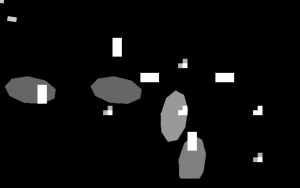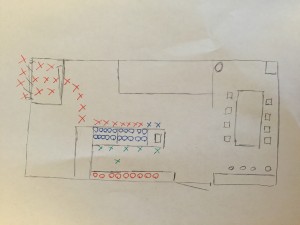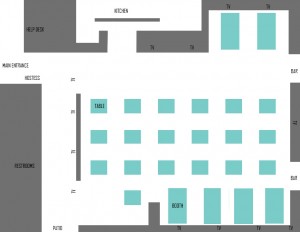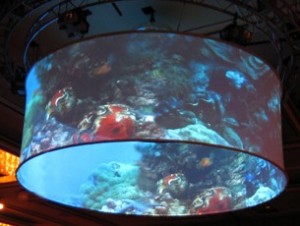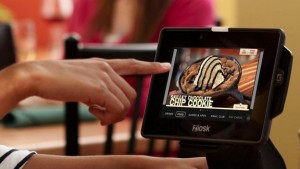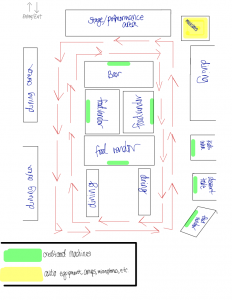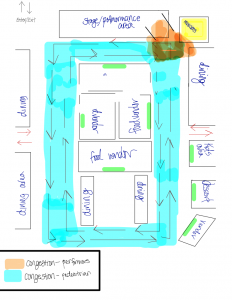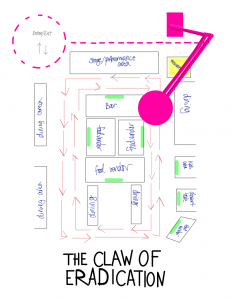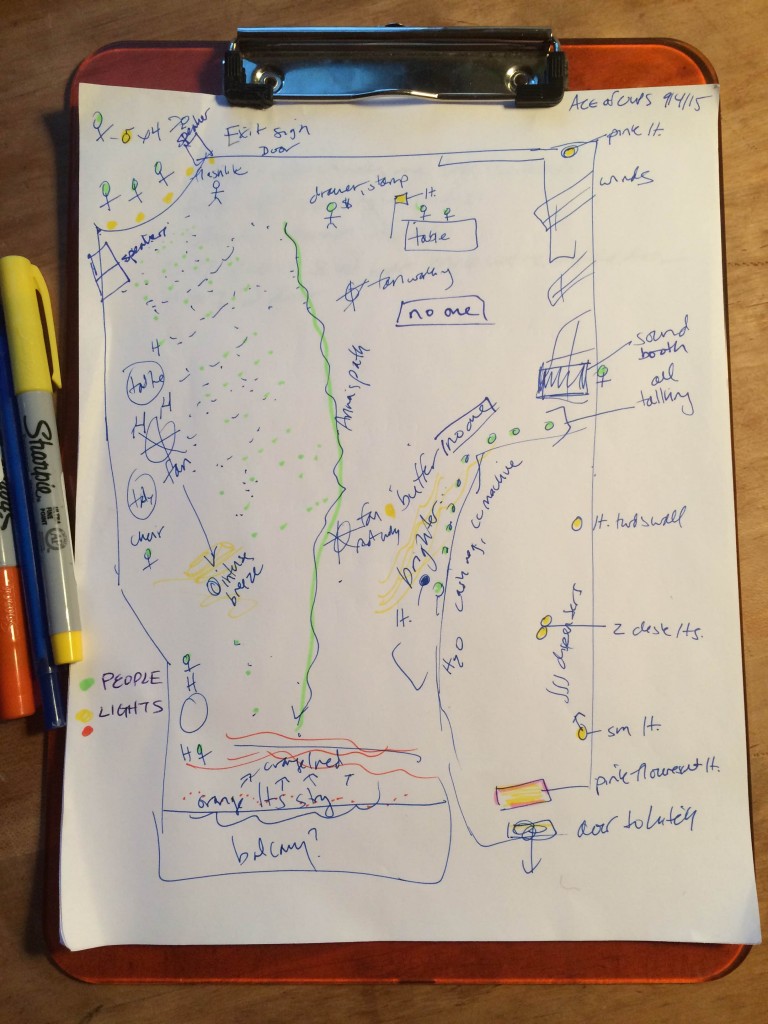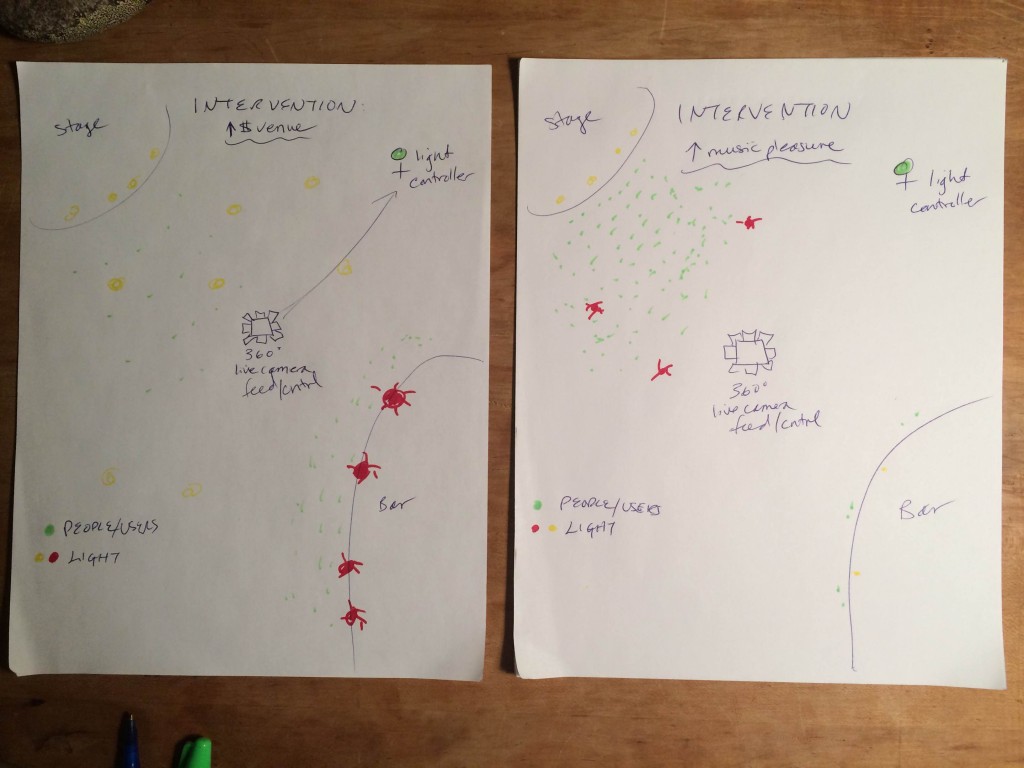Peter’s Popping Pressure Project (1)
Posted: September 22, 2016 Filed under: Pressure Project I Leave a comment »For my first pressure project, I wanted to explore a sort of gameified concept. This project has two main components to it – popping digital bubbles by moving within their volume (this component is shown in the attached video – sorry it’s sideways!), and experiencing yourself via a third-person perspective (not in the video, but experienced in class).
My inspiration for the latter aspect of the experience came from staying up until 5am one night whilst demonstrating VR to friends from my dorm. We ended up streaming local video calls into the head mounted display, and were able to watch ourselves walk through the environment from a fixed perspective. I found it profound how quickly my mind associated with my third-person self and how different the experience is when navigating a space in such a way. I wanted to use that idea and make it accessible to everyone, so my solution was to have the computer’s camera at a different location from that of the screen, and encourage the users to conceptualize fine motor skills from this new perspective.
And that leads into the former means of interaction – popping bubbles. The bubbles both function as an encouragement to move about the space, as well as a curiosity to learn how we as participants can effect them. Their mechanic is they spawn in at random locations on the screen (faster if there is no motion in the environment), and the bubbles will pop once a user collides with a bubble (as seen from the camera’s perspective). To add curiosity and engage more senses, I caused the bubbles to play a MIDI sound each time they are popped, whose pitch is determined by the total motion within the camera’s field of view.
This system was achieved through clipping the incoming video signals into small portions, then dividing them apart into a 10 x 10 array. That array then detects motion within each 1 x 1 grid component, and will pop a bubble if there is enough motion and a bubble is present in that coordinate.
It was very enjoyable to observe everyone interact with this system; similar to how we stepped back and observed the workings of our “Conwy’s Game of Life” experience in the Motion Lab, taking the time to simply observe the users instead of their associated video makes the experience truly feel performative. The rules set forth by this patch caused users to move delicately as well as chaotically, in attempts to discover what the system’s rules are. I found it interesting that many users did not associate the popping of bubbles with their movements, as well associate the playing of audio when bubbles are popped, until 2 – 4 minutes into the experience (however seeing as I was the one who designed the system, I was quite blind to how it would look for a first-timer). Overall this project was very fun, and I enjoy seeing how everyone interacted with these different systems!
pp1 <– Isadora patch
Pressure Project 1 __ Taylor
Posted: September 22, 2016 Filed under: Assignments, Isadora, Pressure Project I, Reading Responses, Taylor | Tags: #frogger:) Leave a comment »Under Pressure, dun dun dun dadah dun dun
Alright… so I got super frustrated fiddling around in Isadora and my system ended up being what I learned from my failures in the first go round. Which was nice because I was able to plan based on what I couldn’t and didn’t want to do, leading me to make simpler choices. It seemed like everyone was enthusiastically trying to grok how to interact with the system. It felt like it kept everyone entertained and pretty engaged for more than 3 minutes. ? Some of the physical responses to my system were getting up on the feet, flailing about, moving left to right and using the depth of the space, clapping, whistling, and waving. Some of the aesthetic responses to my system were that the image reminded them of a microscope or a city. I tried to use slightly random and short intervals of time between scenes and build off of simple rules and random generators (and slight variations of the like), in an attempt to distract the brain away from connecting the pattern. For a time it seemed this proved successful, but after many cycles and finding out the complexities were more perceived than programmed enthusiasm waned. I really enjoyed this project and the ideas of scoring and iterations that accompanied it.
Actors I jotted down, that I liked in others processes: {user input/output/ create inside user actor}{counter/certain#of things can trigger}{alpha channel/ alpha mask}{chroma keying/ color tracking}{motion blur / can create pathways with rate of decay ? }{gate / can turn things on/off}{trigger value}
Reading things:
media object- representation
interaction, character, performer
scene, prop, Actor, costume, and mirror
space & time | here, there, or virtual / now or then
location anchored to media (aural possibilities), instrumental relationship, autonomous agent/ responsive, merging to define identity (cyborg tech), “the medium not only reflects back, but also refracts what is given” (love this). “The interplay between dramatic function / space / time is the real power — expansive range of performative possibilities …< <107/8ish.. maybe>>
Pressure Project 1
Posted: September 20, 2016 Filed under: Pressure Project I Leave a comment »Pressure Project 1:
1. I aimed to control the jump between the scenes by using camera feed, also arranged auto jumps by using trigger delay. The sudden jumps between the scenes created a playfulness and unpredictability. The jump from first to second scene is controlled by the movement. After the triangle is pushed to upper part of the scene with the movement feed the scene jumps to next one.
2. I used the sound watcher to control the density of the explode filter.
3. There are two different colorizers in two different scenes. First one is controlled by the wave generator, second one is controlled by the movement and camera feed.
4. There is an animation in loop on the 4th scene, based on the horizontal movement of the viewer the colors change between cyan and magenta or yellow and purple.
5. Last scene is controlled by color. By using chromakey object I paired up a cyan square to blue chromakey and yellow square to yellow chromakey object. Therefore, each square follows the object it’s pair (blue object movement controls blue square, yellow object movement controls the yellow object.)
Very helpful assignment, I learned a lot about interactivity. Also, It is fun to watch the contribution of the classmates, it carries the project to a different level.karaca_pp1-izz
Pressure Project #1
Posted: September 16, 2016 Filed under: James MacDonald, Pressure Project I Leave a comment »For my first pressure project, I wanted to create a system that was entirely dependent on those observing it. I wanted the system to move between two different visual ideas upon some form of user interaction. I used the Eyes++ actor to control sizes, positions and explode parameters of two different shapes while using the loudness of the sound picked up by the microphone to control explode rates and various frequency bands to control the color of the shapes. The first scene, named “Stars,” uses two shapes, sent to four different explode actors, with one video output of the shapes actor being delayed by 60 frames. The second scene, “Friends,”, uses the same two shapes, exploding in the same way, but this time, adds an alpha mask on the larger shapes of the incoming video stream with either a motion blur effect or a dots filter.
Before settling on the idea of using sound frequencies to determine color, I originally wanted to determine the color based on the video input. Upon implementing this, I found that my frame rate dropped dramatically, from approximately 20-24 FPS to 7-13 FPS, thus leading me to use the sound frequency analyzer actor instead.
While I was working on this project, I spent a lot of time sitting directly in front of my computer, often in public places such as the Ohio Union and the Fine Arts Library, which resulted in me testing the system with much more subtle movements and quieter audio input. In performance, everyone engaged with the system from much further back than I had the opportunity to work with, and at a much louder volume. Because of this, the shapes moved around the screen much more rapidly and lead to the first scene ending rather quickly and the second scene lasting much longer. The reason for this is because the transition into the second scene was triggered by a certain number of peaks in volume, whereas the transition back to the first scene was triggered by a certain amount of movement across the incoming video feed.
One of the things I would wish to improve on if I had more time would be to fine-tune the movement of shapes across the screen so they would seem a little less chaotic and a little more fluid. I also would want to spend some time trying to optimize the transition between the scenes, as I noticed a visible drop in frame rate.
Zip Folder with the Isadora file: macdonald_pressure_project01
The Fly
Posted: September 15, 2016 Filed under: Pressure Project I, Robin Ediger-Seto, Uncategorized Leave a comment »This is Fly
Make sure your camera is on.
Try clapping at it.
https://www.dropbox.com/s/rx077164kz1ikai/fly.izz?dl=0
I had no clue what I was going with this, to the point that I was frustrated, and then I realized that this frustration could be one of my resources. One of the more frustrating things in this world are flies. Inspired by these creatures and the need to use the Eyes ++ actor I created a Digital fly the moves when you move and then rest on the last thing that moved, presumably you. I am not a computer programmer and the logic to make this work took most of my time. They need to use The jump actor forced me consider how to progress the story. As flies of the most annoying thing in the world (maybe slight hyperbole) the most satisfying thing (again hyperbole) is to get them. I integrated a system whereby the scene would jump when movement is detected around the fly and a sound is as loud as a clap is heard. To capture to frustration created by a fly I made it so that ones you killed it more would show up. Well doing this I made a scene in which a fly would just fly around. The previous scene jumps to at one time and I decided it was fly heaven and get back to it you have to apologize. I worked up kinks and counter actors as well as made it one more pretty and here is Fly.
Once I finish this assignment I wondered if it was generative. I came to the conclusion is not completely generative. They are fairly basic set outcomes however how you get there is different. The user has a score but what they do can differ. Also, the aspects of the fly are completely randomized including movement and color.
Jenis High Street Short North
Posted: September 9, 2015 Filed under: Josh Poston, Pressure Project I Leave a comment »Jeni’s
Friday September 4th
10-11pm
I have yet to walk into a Jenis Ice Cream that has a well-designed traffic or work flow model. Customers enter into the store through the main entrance. They approach a counter that has all of the flavors of ice cream twice linearly enabling more employee workstation. However this is limited by the presence of a single workstation setup on the back counter where all of the necessary condiments and garnishes are. This leads to a turn around and wait until the path is unoccupied by the other employees that are all heading to the same point.
If a customer is unfamiliar with the setup they will not understand that the flavors are repeated at the two ice cream coolers and stand unknowingly at the first one reluctant to miss a flavor. This is something I have witnessed several times due to the lack of signage indicating the proper protocols as a customer. Protocol involves in this instance always moving forward. From waiting to order to, and having placed your order until checkout.
I would propose that the system would benefit from a call system on the back wall that would bring the necessary item to the ice cream preparer rather then them having to fight the crowd every time. The necessary items are keyed in and then delivered right behind the appropriate individual. Additionally Jeni’s should acquire spaces that allow for an increased traffic flow. My drawing implies that there is much more open space than there actually is within the store. There could also be interactive signage or a system that can tell people when to move forward, welcome them, inform them of the general flow model of the space, or perhaps assist them in making decisions, it could tell them some good flavor combinations based on different desires.
Pressure Project 1
Posted: September 9, 2015 Filed under: Pressure Project I, Sarah Lawler Leave a comment »Location: Buffalo Wild Wings
Time: During Happy Hour
Observation: Happy hour was not as crowded as I thought it would be. I would imagine that if a big game was being aired there, the place would be packed. I’m going to base this devised piece off a packed Buffalo Wild Wings. When observing the waiters/waitresses I noticed the amount of maneuverability between tables is quite difficult for them due to the amount of chairs that are in the way. I also noticed there are not enough TV’s to compensate for the amount of tables that are within the room if say everyone wanted to watch their own game if multiple games were taking place.
Devise: Build tablets and card readers into the table to minimize the amount of traffic that is taking place throughout the restaurant. By installing tablets within the table, one could order food, drinks, ask for extra napkins, pay bill etc. without having anyone walk over until food needs to be delivered. They would also have total control over what they can watch. The TV would need be separate from the tablet so the customer would not have to be staring down at the table throughout their whole experience there. A 360degree projection would serve as the TV. It would sit above the table so everyone at the table can still be seen by one another.
PP1: Greek Festival/Claw of Eradication
Posted: September 7, 2015 Filed under: Alexandra Stilianos, Pressure Project I Leave a comment »Get started: When asked to go to a public place and make hypothetical choices that will affect the general population, the urge to (theoretically) choose malevolency was too strong an urge to ignore. Also, first instincts were embraced and explored.
Location: Columbus Greek Festival, Courtyard
Food: My favorite Greek pastry, galaktoboureko- Delicious
Map: I choose to observe the courtyard area of the festival which served multiple functions. The east side of the lot held the entrance, a performance space for folk dancing and a small stage with a band and various musicians. The center and rest of the space held portable tables for dining and various food/alcohol vendors. The flow of traffic moved erratically (as would any festival) but most often it was cyclical. Existing major technologies were listed in the legend but also included my main focus/perpetrator: the cellphone.
Notes: The highest areas of congestion were around all the vendors as one would suspect but the corner that shared space between access to the bar, stage, musicians and dining area was the most dense. Not only because of sheer numbers, alcohol consumption and children running erratically waiting to perform but a common 2015 problem: the multitasking text and walk combo. While this problem was illuminated in this space, it is a common problems in all areas of the festival (not to mention shopping malls, side walks, the oval, etc.). While hardly anyone can admit to being innocent of this crime, it is more problematic in a setting such as a small festival than it is in a large, public area. For that reason, I choose to devise a system that was effective, isolated and also a bit hilariously cruel.
Devise:
“The class is our master, the claw chooses who will stay and who will go.”- Alien’s, Toy Story
I devised a crane of sorts that can eradicate people who have, in a congested public space, become an obstruction because of their absorption in their devices (particularly, smartphones.) This would be done by a sensor who reads body posture, as well as other factors, and in a sort-of magnetic field, alien abduction-esque way, be lifted from the space and returned to the entrance where they can re-enter after disregarding their distraction.
I used the ability to ignore actualities of creating this device freely but did determine three factors that needed to be taken in account when determining who gets ejected. They are:
- Device in hand
- Curvature of cervical spine
- Forward mobility
The Claw would have a system of sensors that had the ability to read these various requirements and would only eject perpetrators that met all three. The first would require some sort of heat sensor that could detect the phone was out of a pocket or purse and touching human skin. Then it would also be able to detect the curvature of the cervical spine, since a person can walk and talk on the phone more effectively than when they are hunched over staring at the ground. The final requirement is the necessity for the subject/victim to be in a forward motion, a considerate person can step aside out of a traffic pattern to complete their cellular duties, which should not be punished.
Conclusion: While this solution is highly impractical in the ‘real’ world, it was enjoyable to not only observe and find a solution, it also gave me a sinister satisfaction to deal with a pet peeve of mine. All the while, with a devising experiential mind.
OPA!
Pressure Project I – Anna
Posted: September 5, 2015 Filed under: Anna Brown Massey, Pressure Project I 2 Comments »
Counterfeit Madison performs her Femme Fest set at Ace of Cups. Shot 09/04/15 at Femme Fest for Alive. (Meghan Ralston)
Showing up at a music venue on a holiday weekend with a clipboard and pen is a strong indication that you’re not only a graduate student, but you’re also a certified dweeb.
Putting that clipboard down, transfixed by Counterfeit Madison and her ability to set your feet deeply into the earth while landing you on the moon, is a strong indication that to be both wholly human and to devise experiential media systems (DEMS) you’ve got to fall headlong into the user-experience.
Devising EMSs requires analyzing existing media systems, which means approaching a local music show with an eye/ear/body-cognition towards scrutiny and (hypothetical) disruption. As a theater-maker, this is a familiar brain setting, but that night I practiced with some newly-attractive terms, like “present technology,” “user,” and “product.”
Public Place
2100 hours Friday 4th September
Ace of Cups, Femmefest
Columbus, Ohio
Users
Users: I am the user/audience member along with fellow ~200 payers-of-the-$7-cover.
Non-users / Purveyors of Product, in order of appearance:
- Bouncer
- Cashier
- Musicians
- Bartenders
- Barbacks
- Sound technician
- Merch seller
Products
Music and booze (also: social interaction, public space to smoke)
Existent Technology
- Electric Marquis
- Swinging Door
- Flashlight
- Drawer
- Overhead lights
- Standing lamps
- Wall lamps
- Fan overhead
- Air Conditioning (likely though undetected)
- Selected sound amplification: mics, speakers, control board
- Sound instruments: guitars, drumset, keyboard
Description of locomotive and stance choices by users:
ABM: As I enter the space, to my right forward diagonal stands a person who cups their hand in the Western shape for “ID requested.” I provide it: flashlight used. “You can pay the $7 cover there.” I turn towards their gesture and exchange money for a stamp on my hand.
I pause. There is a wide swath of space between me and the other users, all turned not quite in my direction but slightly to their own left, away from my right shoulder. I square my shoulders and curve leftward around the ragged edges of the crowd in the light, looking into the room for people whom I know. I feel dozens of eyeballs peering blankly back. I walk quickly towards the bar, a place of physical refuge. It’s a wall I can lean against. I feel awkward. And I have a clipboard.
I think immediately in the same tone that Seinfeld used when exclaiming “Newman!”: lighting. This lighting is making me uncomfortable. It’s both too bright and, I discover, inconsistent, as I sashay up to a far stage left corner and feel spotlighted. I am also under an overhead fan, always an enemy for the cold-blooded, blowing a winter wind through me. There’s a strange cluster of high bar tables with empty chairs at house left with no one in them.
The decibel level sounds perfect. The music is loud enough to drop in and engage, and quiet enough for me to chat over the less-engaging songs (of a rather fantastic high school) opening band with friends.
But that light. I keep looking back at the bar, in front of which there is a single piercing light that creates a buffer zone–or is it just a natural shaping of people between bar and standing-as-audience-space? But the light, I’m having trouble determining–does it draw people to the bar or repel people from it? The light-level has two purposes here:
1. To light workers at a level at which they can execute their job.
2. To get users to buy the product.
These goals lend themselves to the reminder of the hierarchy of economic gain. Small music venues (let’s go with 250<) make the bulk of their income from the drinks slung. Cover cash goes to the musicians. Last night would have been within that system but for the nature of fundraiser: the musicians were working for free.
Interventions
If our goal is to increase the monetary income of Ace of Cups:
Intervention: Alteration of lighting to draw users from the music and towards the bar.
Some facts:
Theaters are dark in order to provide an immersive experience. (Can we say that’s fact? Let’s just say that’s fact.)
Bars often have red lights because Western people think people look sexier under a red light. (Can we say that’s fact? Let’s just say that’s fact.)
Small music venues want to maximize the number of drinks sold by:
- Getting as many users in the door as possible to maximize possible users.
- Keeping those users in the venue so they buy drinks
- Making the bar/product attractive so they buy the drinks
I would apply a red “gel” to the lights at the bar and redirect this light not only onto the users, but also the non-users. Pupils dilate, people feel good about themselves at the bar, and hence, they’re drawn to the bar to buy product. I would not lower the lights in the rest of the venue; doing so would lend more other-product (live music) pleasure to the users, but fewer users would turn to the bar as refuge. Sound quality should remain at current levels – music is listen-able but talkable. The venue has is economic incentive for the sound quality to not just be good for the pleasure of listening–and the safety of ears–but for the sound/lights/space contours/temperature to steer customers to the bar.
If our goal is to increase the pleasure in the music product by users at Ace of Cups:
Intervention: a computer-responsive lighting system that darkens parts of the room to gather users closer to the stage. Computer-controlled sensors will pick up the presence of objects in space from a top-view, and the algorithm would darken areas according to a quantified distance of space between users, and raising lights in peripheral spaces to shift users towards each other. People feel more comfortable being closer to each other and closer to the stage when they’re in the dark, and have more pleasure in the music product. (Can we say that’s fact? Let’s just say that’s fact.) This system can also be controlled by a trained worker who has an elevated view of the crowd.
